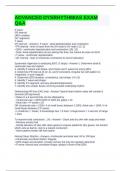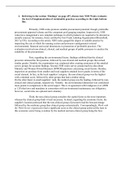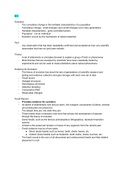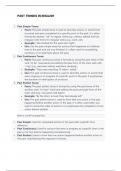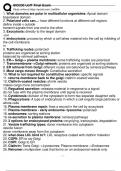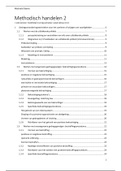ADVANCED DYSRHYTHMIAS EXAM
Q&A
P wave:
PR interval:
QRS complex:
(ST segment)
T wave:
QT interval: - Answer-• P wave - atrial depolarization and contraction
• PR interval - time of travel from the SA node to AV node (.12-.2)
• QRS - ventricular depolarization and contraction (.08-.12)
- Note: Atrial repolarization occurs during this time, but cannot be seen on EKG
• T wave - ventricular repolarization
• QT interval - start of ventricular contraction to end of relaxation
Systematic Approach to analyzing EKG (7 steps) - Answer-1. Determine atrial &
ventricular rate and rhythm.
2. Identify P waves and shape, and if there are P waves for every QRS.
3. Determine PR interval (0.12-.2), and if consistent, irregular but with pattern to
irregularity, or just irregular.
4. Determine QRS duration, consistency, and shape. (<0.12)
5. Identify T wave and shape.
6. Identify ST segment, and any elevation/depression.
7. Identify any ectopic beats occurring outside underlying rhythm.
Determining HR from EKG strip - Answer-Typical heart rhythm strips will contain 6
seconds (30 big boxes)
• Rates in a 6 second strip can be obtained by
- Ventricular rate = QRS (QRS to QRS-the gaps) x 10
- Atrial rate = P waves x 10
OR Ventricular rate = 1500 / # of small boxes between 2 QRS; Atrial rate = 1500 / # of
small boxes between 2 P waves
• 1 small box = .04sec, 5 boxes/large box = 0.2sec; 5 large boxes = 1 second, 15 large
= 3sec
To improve lead conduction... (4) - Answer-- Clean and dry skin with soap and water
- Remove excess hair
- Gentle abrasion of skin with clean gauze to expose epidermis (dry gauze, not alcohol
which acts as barrier, skin is a natural conductor)
- Have patient remain still and supine
Normal Sinus Rhythm - Answer-• Ventricular and atrial rate: 60 to 100 bpm
• Ventricular and atrial rhythm: Regular
• QRS shape and duration: Usually normal, but may be regularly abnormal
• P wave: Normal and consistent shape; always in front of the QRS
, • PR interval: Consistent interval between 0.12 and 0.20 seconds
• P:QRS ratio: 1:1
Sinus Bradycardia - Answer-• Atrial/ventricular rate and rhythm: < 60 and regular
• P wave: Normal and consistent shape; always in front of QRS
• PR interval: Consistently between 0.12 and 0.2 seconds
• QRS shape and duration: Usually normal, but may be regularly abnormal
• Concern - decreased cardiac output and tissue perfusion
Etiology of Sinus Brady (causes) - Answer-• Lower metabolic needs - Sleep, Athletes,
Hypothyroidism
• Vagal stimulation (triggers parasympathetic) - Vomiting, Suctioning, Pain
• Medications - CCB, BB, Amiodarone
• Idiopathic sinus node dysfunction
• Increased intracranial pressure
• Coronary artery disease
*Management will depend on cause and symptoms
H's and T's for abnormal heart rhythms (6/5) - Answer-• Hypovolemia - weight loss, low
BP, incr. HR, concentrated blood (high hematocrit), turgor/tenting
• Hypoxia - cyanosis (mouth, periphery, O2 sat below 95-100)
• Hydrogen ion (Acidosis) - more hydrogen ions, ABG (low pH, bicarb ≤22, low CO2 =
compensation, CO2 will be high if the cause bicarb above 26)
• Hypo/hyperkalemia - weakness, change in T waves
• Hypoglycemia - cold and clammy give candy
• Hypothermia
• Toxins - meds, comorbidities, kidneys (main excreters - will see high BUN, Cr, decr.
urine and GFR)
• Tamponade, cardiac - fluid buildup around heart
• Tension pneumothorax - collapsed lung r/t air; will present with absent breath sounds
on affect side, low O2 sat, tracheal shift, SOB
• Thrombosis - chest pain, neuro changes, etc.
• Trauma
Sinus Tachycardia - Answer-• Atrial/ventricular rate and rhythm: > 100, but < 120 and
regular
• P wave: Normal and consistent shape; always in front of QRS
• PR interval: Consistently between 0.12 and 0.2 seconds
• QRS shape and duration: Usually normal, but may be regularly abnormal
Etiology of Sinus Tachycardia - Answer-• Physiologic or psychological stress -
movement, anxiety, pain, stimulants (drug, caffeine)
• Sympathetic stimulants
• Enhanced SA node automaticity
• Autonomic dysfunction
Q&A
P wave:
PR interval:
QRS complex:
(ST segment)
T wave:
QT interval: - Answer-• P wave - atrial depolarization and contraction
• PR interval - time of travel from the SA node to AV node (.12-.2)
• QRS - ventricular depolarization and contraction (.08-.12)
- Note: Atrial repolarization occurs during this time, but cannot be seen on EKG
• T wave - ventricular repolarization
• QT interval - start of ventricular contraction to end of relaxation
Systematic Approach to analyzing EKG (7 steps) - Answer-1. Determine atrial &
ventricular rate and rhythm.
2. Identify P waves and shape, and if there are P waves for every QRS.
3. Determine PR interval (0.12-.2), and if consistent, irregular but with pattern to
irregularity, or just irregular.
4. Determine QRS duration, consistency, and shape. (<0.12)
5. Identify T wave and shape.
6. Identify ST segment, and any elevation/depression.
7. Identify any ectopic beats occurring outside underlying rhythm.
Determining HR from EKG strip - Answer-Typical heart rhythm strips will contain 6
seconds (30 big boxes)
• Rates in a 6 second strip can be obtained by
- Ventricular rate = QRS (QRS to QRS-the gaps) x 10
- Atrial rate = P waves x 10
OR Ventricular rate = 1500 / # of small boxes between 2 QRS; Atrial rate = 1500 / # of
small boxes between 2 P waves
• 1 small box = .04sec, 5 boxes/large box = 0.2sec; 5 large boxes = 1 second, 15 large
= 3sec
To improve lead conduction... (4) - Answer-- Clean and dry skin with soap and water
- Remove excess hair
- Gentle abrasion of skin with clean gauze to expose epidermis (dry gauze, not alcohol
which acts as barrier, skin is a natural conductor)
- Have patient remain still and supine
Normal Sinus Rhythm - Answer-• Ventricular and atrial rate: 60 to 100 bpm
• Ventricular and atrial rhythm: Regular
• QRS shape and duration: Usually normal, but may be regularly abnormal
• P wave: Normal and consistent shape; always in front of the QRS
, • PR interval: Consistent interval between 0.12 and 0.20 seconds
• P:QRS ratio: 1:1
Sinus Bradycardia - Answer-• Atrial/ventricular rate and rhythm: < 60 and regular
• P wave: Normal and consistent shape; always in front of QRS
• PR interval: Consistently between 0.12 and 0.2 seconds
• QRS shape and duration: Usually normal, but may be regularly abnormal
• Concern - decreased cardiac output and tissue perfusion
Etiology of Sinus Brady (causes) - Answer-• Lower metabolic needs - Sleep, Athletes,
Hypothyroidism
• Vagal stimulation (triggers parasympathetic) - Vomiting, Suctioning, Pain
• Medications - CCB, BB, Amiodarone
• Idiopathic sinus node dysfunction
• Increased intracranial pressure
• Coronary artery disease
*Management will depend on cause and symptoms
H's and T's for abnormal heart rhythms (6/5) - Answer-• Hypovolemia - weight loss, low
BP, incr. HR, concentrated blood (high hematocrit), turgor/tenting
• Hypoxia - cyanosis (mouth, periphery, O2 sat below 95-100)
• Hydrogen ion (Acidosis) - more hydrogen ions, ABG (low pH, bicarb ≤22, low CO2 =
compensation, CO2 will be high if the cause bicarb above 26)
• Hypo/hyperkalemia - weakness, change in T waves
• Hypoglycemia - cold and clammy give candy
• Hypothermia
• Toxins - meds, comorbidities, kidneys (main excreters - will see high BUN, Cr, decr.
urine and GFR)
• Tamponade, cardiac - fluid buildup around heart
• Tension pneumothorax - collapsed lung r/t air; will present with absent breath sounds
on affect side, low O2 sat, tracheal shift, SOB
• Thrombosis - chest pain, neuro changes, etc.
• Trauma
Sinus Tachycardia - Answer-• Atrial/ventricular rate and rhythm: > 100, but < 120 and
regular
• P wave: Normal and consistent shape; always in front of QRS
• PR interval: Consistently between 0.12 and 0.2 seconds
• QRS shape and duration: Usually normal, but may be regularly abnormal
Etiology of Sinus Tachycardia - Answer-• Physiologic or psychological stress -
movement, anxiety, pain, stimulants (drug, caffeine)
• Sympathetic stimulants
• Enhanced SA node automaticity
• Autonomic dysfunction

